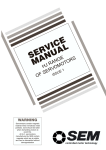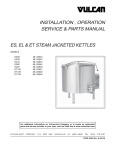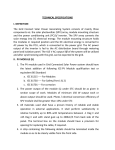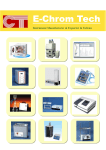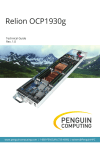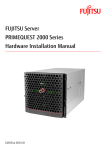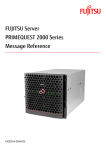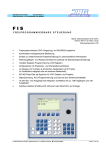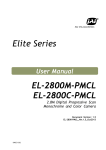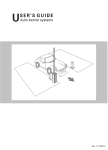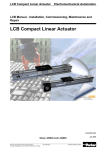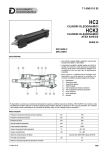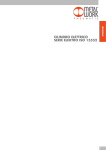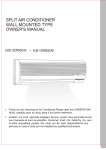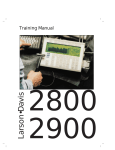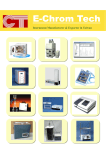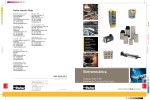Download ET Electro-thrust cylinders - Virtus
Transcript
ET Electro-thrust cylinders Electromechanical Automation ET manual - Mounting, Setup, Maintenance, Repair ET Electro-thrust cylinders - metrical 192-550013 N6 July 2008 We reserve the right to make technical changes. The data correspond to the current status at the time of printing. 07.08.08 10:43 192-550013 N6 July 2008 ET Electro-thrust cylinders Introduction ____________________________ Production site: C E R T I F I E D DIN EN ISO 9001 U M Q A L T IT Y S S Y E Reg. Nr. 36 38 Parker Hannifin GmbH & Co. KG Electromechanical Automation Europe [EME] Robert-Bosch-Strasse 22 77656 Offenburg (Germany) Tel.: + 49 (0781) 509-0 Fax: + 49 (0781) 509-98176 Internet: www.parker-automation.com http://www.parker-automation.com E-mail: [email protected] mailto:[email protected] Parker Hannifin GmbH & Co. KG - registered office: Bielefeld - Amtsgericht: Bielefeld HRA 14808 Personally liable shareholder: Parker Hannifin Management GmbH - Amtsgericht: Bielefeld HRB 35489 executive board: Dr. Gerd Scheffel, Günter Schrank, Christian Stein, Kees Veraart, Hans Wolfs - Chairman of the board: Hansgeorg Greuner Headquarters: Italy: Great Britain: Parker Hannifin S. p. A • Electromechanical Automation • Via Gounod 1 • I-20092 Cinisello Balsamo (MI), Italy • Tel.: +39 (0)2 361081 • Fax: +39 (0)2 36108400 • E-mail: www.parker-automation.com http://www.parker-automation.com • Internet: www.parker-automation.com http://www.parker-automation.com Parker Hannifin plc • Electromechanical Automation • Arena Business Centre • Holy Rood Close • Poole, Dorset BH17 7FJ UK • Tel.: +44 (0)1202 606300 • Fax: +44 (0)1202 606301 • E-mail: [email protected] mailto:[email protected] • Internet: www.parker-automation.com http://www.parker-automation.com Worldwide sales http://apps.parker.com/divapps/eme/EME/Contact_sites/Sales%20Channel_Parker -EME.pdf Nonwarranty clause We checked the contents of this publication for compliance with the associated hard and software. We can, however, not exclude discrepancies and do therefore not accept any liability for the exact compliance. The information in this publication is regularly checked, necessary corrections will be part of the subsequent publications. Internet: Additional information: Our product on the Internet: http://www.parker-eme.com/et 2 192-550013 N6 July 2008 Parker EME Introduction Contents 1. Introduction ................................................................................................ 4 1.1 1.2 1.3 Device assignment..................................................................................... 4 Type specification plate ............................................................................ 4 Safety Instructions..................................................................................... 5 1.3.1. 1.3.2. 1.3.3. 1.3.4. 1.3.5. 1.3.6. General hazards ................................................................................................... 5 Intended use......................................................................................................... 5 Identifying Residual Dangers and Hazardous Areas ....................................... 5 Working safely ..................................................................................................... 6 Safety Instructions for the Company Using the System ................................. 6 Safety Instructions for Operating Personnel .................................................... 6 1.4 Packaging, storage, transport................................................................... 7 1.5 1.6 Warranty conditions .................................................................................. 9 Conditions of utilization ............................................................................ 9 1.4.1. Special notes on transport ................................................................................. 8 2. Set-up ..........................................................................................................11 2.1 Mounting ..................................................................................................... 11 2.1.1. 2.1.2. 2.1.3. 2.2 Electric installation .................................................................................... 14 2.2.1. 2.2.2. 2.3 Mounting with mouting threads on the cylinder .............................................. 11 Mounting with mounting accessories ............................................................... 12 Mounting notes .................................................................................................... 13 2.1.3.1 Horizontal Mounting .................................................................................. 13 2.1.3.2 Vertical mounting ...................................................................................... 13 2.1.3.3 Mounting of the payload............................................................................ 14 Mounting and connection of the travel limit switches..................................... 14 End limits.............................................................................................................. 17 Motor mounting - exchange of motor....................................................... 19 3. Maintenance ...............................................................................................21 3.1 Relubrication .............................................................................................. 21 4. Repair ..........................................................................................................23 5. Specifications.............................................................................................24 5.1 5.2 5.3 5.4 5.5 5.6 Determine maximum possible mechanical stroke .................................. 26 Permissible side loads .............................................................................. 27 Thrust force factor and breakaway torque............................................... 29 Transmissible torques in parallel drive mounting .................................. 30 Nominal lifetime ......................................................................................... 31 Dimensions................................................................................................. 33 6. Accessories ................................................................................................35 6.1 Configuration of the thrust rod ................................................................. 35 6.1.1. 6.1.2. 6.1.3. 6.2 Mounting options ....................................................................................... 38 6.2.1. 6.2.2. 6.2.3. 6.2.4. 6.2.5. 6.2.6. 6.2.7. 6.2.8. 6.3 Rod Clevis ............................................................................................................ 36 Sperical Rod Eye.................................................................................................. 36 Flexible coupling.................................................................................................. 37 Rod guiding .......................................................................................................... 38 Centre trunnion mounting .................................................................................. 40 Rear Eye Mounting .............................................................................................. 40 Rear Clevis ........................................................................................................... 41 Bearing Block....................................................................................................... 41 Installation flanges .............................................................................................. 42 Foot mounting...................................................................................................... 42 Mounting flanges ................................................................................................. 42 Initiators / limit switches ........................................................................... 43 7. Order code ..................................................................................................44 8. Index............................................................................................................47 9. Internet ........................................................................................................48 192-550013 N6 July 2008 3 ET Electro-thrust cylinders Introduction 1. Introduction In this chapter you can read about: Device assignment ...............................................................................................................4 Type specification plate........................................................................................................4 Safety Instructions ................................................................................................................5 Packaging, storage, transport ..............................................................................................7 Warranty conditions..............................................................................................................9 Conditions of utilization ........................................................................................................9 1.1 Device assignment This manual is valid for the following devices: Electro-thrust cylinders for standard NEMA motors: ETS32 ETS50 ETS80 Electro-thrust cylinder for metric motors and gearboxes as well as special NEMA motors: ETB32 ETB50 ETB80 ETB100 ETB125 Electro-thrust cylinder for metrical motors and gearboxes, but with enhanced lifetime: ETV32 1.2 ETV100 Type specification plate The exact designation of the linear module is marked on the type specification plate Example: ETB50M05PA57FMA450A Explanation: ET B Frame Size 50 Screw Lead M05 Motor mounting position P Ratio A prepared for (Code no. drive) 57 Mounting type F Thrust rod type M Housing orientation A Stroke in mm 450 Designation/Protection class A Details can be found in the Order code (see page 44). Product designation Design 4 192-550013 N6 July 2008 Parker EME Introduction 1.3 Safety Instructions 1.3.1. General hazards General Hazards on Non-Compliance with the Safety Instructions This machine component has been designed in accordance with state-of-the-art technical developments and is operationally reliable. If it is not operated by qualified or at least trained personnel or if it is operated improperly or not in accordance with the operating instructions, however, the unit may bear the risk of hazards. Electronic, moving and rotating components can danger for life and limb of the operator or third persons cause material damage If the linear actuator is installed in a machine plant, the safety requirements noted in the operating instructions for that machine must be combined with those described in this manual. 1.3.2. Intended use The linear actuator has a number of uses including: Positioning, transporting, feeding, removing, pallet handling, loading, unloading, processing and manipulating workpieces or tools. Since the component can be used in a very wide range of applications, the user is responsible for its use in specific applications. Please make sure that the mounting of parts or tools will not pose a threat to persons or cause damages to any parts or devices. This also applies, for example, to the case of a broken timing belt. The linear actuator must only be used in areas that are not accessible to persons during operation. If the linear actuator is used in areas accessible to people, it must be installed in such a manner that no one can be endangered during operation. 1.3.3. Identifying Residual Dangers and Hazardous Areas If there are still residual dangers present to persons or property from the linear actuator in spite of operating it in a safe manner, the user must make reference to these residual dangers through signs and written rules requiring appropriate procedures. The following safety signal words are used: Danger Indicates that an imminent hazardous situation may lead to death or serious bodily harm -if not prevented using appropriate safety measures-. Warning Indicates a potentially hazardous situation which, if not avoided using appropriate safety measures, could result in serious or minor injury. Caution Indicates a potentially hazardous situation which, if not avoided using appropriate safety measures, may result in minor injury or damage.- Hint Provides important information about the product, how to handle the product or about the part of the manual to which particular attention must be paid. 192-550013 N6 July 2008 5 ET Electro-thrust cylinders Introduction 1.3.4. Working safely Heed the Instructions The information (such as instructions and notes) contained in this manual must be heeded for all work involved in installing, commissioning, setting up, operating, changing operating conditions and modes, servicing, inspecting and repairing the unit. The manual must be available close to the linear module during the performance of all tasks. It is impermissible to operate the liner module if it is not in perfectly functional condition. Operating personnel. The following jobs must only be performed by appropriately trained and authorized personnel: Installation and set-up tasks on the linear actuator Attaching safety transmitter switches (initiators) Connecting the drive and testing the motion direction Instructions for Special Hazards The linear module must be fixed or supported in accordance with the indications in this manual. The operator must ensure that operation of the linear module does not cause any danger. If the linear module moves in hazardous areas, these areas can be safeguarded with safety transmitter switches. 1.3.5. Safety Instructions for the Company Using the System Supervisors must also become familiar with the entire chapter entitled "Safety" and handling required on the linear actuator. Supervisors must ensure that installation and operating personnel have read and understand the chapter entitled "Safety" and the description of how to work with the machine, and that they observe the instructions. The manual must be available close to the linear module during the performance of all tasks. It is impermissible to operate the liner module if it is not in perfectly functional condition. 1.3.6. Safety Instructions for Operating Personnel Any work step that has a negative effect on the operating safety of the linear actuator must be omitted. Operating and supervisory personnel are required to check the linear actuator or machine at least once per shift for externally visible damage or defects. Changes that have occurred (including the operating behaviour) that could have a negative effect on the operating safety must be reported immediately. Components and accessories are designed especially for this product. When purchasing spare and wearing parts, use only original Parker parts. We note here explicitly that we are unable to check or release spare parts or accessories that 6 192-550013 N6 July 2008 Parker EME Introduction were not provided by us. Installing and/or using such products may cause negative changes in the required design properties in some circumstances, which in turn could negatively effect the active and/or passive operating safety of the product. The manufacturer is unable to accept any liability for damage caused by using nonoriginal parts and accessories. Safety and protection devices are strictly NOT to be removed or bypassed or set out of order. Applicable requirements and national accident prevention regulations must always be observed when installing and operating our linear motor module. 1.4 Packaging, storage, transport First check Check the packaging for damages. Remove the packaging. Do not discard the packaging; it is strongly recommended to use the original packaging material for return deliveries. Depending on the storage location, metal surfaces may have a temperature of 0°C or below. Please provide appropriate worker protection (e.g. protective gloves). Please ensure that the consignment does correspond to your order. Check the product for damages. Do never use a device which seems damaged. Please read the installation manual carefully before installing or commissioning the device. Packaging material The packaging material is inflammable, if it is disposed of improperly by burning, lethal fumes may develop. The packaging material must be kept and reused in the case of a return shipment. Improper or faulty packaging may lead to transport damages. Transport Make sure to transport the linear module always in a safe manner and with the aid of suitable lifting equipment (Means of transport (see page 8)). Storage The linear module must be stored evenly and without any mechanical load. Disposal We recommend to dispose of the respective materials in accordance with the respectively valid environmental laws. The following table states the materials suitable for recycling and the materials which have to be disposed of separately. suitable for recycling Disposal Material Option yes no Metal yes no Plastic materials 192-550013 N6 July 2008 7 ET Electro-thrust cylinders Introduction 1.4.1. Special notes on transport Special notes on transport Use only transport equipment with sufficient lifting capacity When using ropes, make certain they are not twisted or knotted. If you are using more than one rope, all the ropes should be equally taut. Never step under overhead loads – danger of being injured! Moving parts must always be secured against slipping or moving. Required minimum load bearing capacity of the means of transport: ET_32 ET_50 ET_80 ET_100 ET_125 80kg 200kg 400kg 750kg 1500kg In these table values, a safety factor of S=8 is taken into consideration (motor and gearbox weight included). This means that it does not represent the cylinder weight. The following threads on the cylinder can be used to mount transport or mounting equipment (for example eye bolts): BG BH 4xJJ DD 8 ET_32 ET_50 ET_80 ET_100 ET_125 DD M6x1.0 M8x1.25 M10x1.5 M12x1.75 M16x2.0 JJ M6x1.0 M8x1.25 M10x1.5 M10x1.5 M12x1.75 BH BG 9 12.7 17.5 24 24 14.5 16 16 16 16 192-550013 N6 July 2008 Parker EME 1.5 Introduction Warranty conditions User Conversions and Changes are Not Permitted The linear actuator must not be changed in its design or in terms of safety without our approval. Any change as defined here made by the user excludes any liability on our part. 1.6 Conditions of utilization General introductory notes With the ET electro-thrust cylinder you bought a product which was manufactured and tested before delivery with the utmost care. Please take your time to read the following notes which you ought to follow closely during setup and operation. The operation of the electro-thrust cylinder is only permitted within the limit values stated in this manual. Unless, all claims under the warranty will become void and a reduced service life or even damages must be expected. Please compare the operating data with the stated limit values especially with reference to: Stroke length and setting of the limit switches, those must be set so that there is a sufficient safety travel at both ends of the travel stroke Even if the limit switches were already mounted at our premises, they must be adapted according to suitable values before operation! Thrust and traction force in the effective direction Lateral force (e.g. as a component of the effective force, but also due to own weight on horizontal mounting, especially with parallel motor mounting and long travel strokes) Velocity Acceleration Environmental conditions (e.g. temperature, contamination) Please do take possible pulses caused by moved masses into consideration for the operating data. (Even small abrupt loads can cause damage, especially if they occur rather often at the same place.) The limit values for the thrust and traction force, lateral force, speed and acceleration are partly influenced by several factors and can change depending on: the size of the electro-thrust cylinder Screw Lead Direct or parallel drive via toothed belt transmission Transmission ratio in the drive Mounting method Mounting orientation vertical or horizontal resp. inclined Travel Stroke If the motor used with the ET cylinder should be able to exceed indivudual limit values of the cylinder, the respective values for the motor must be limited in the control by appropriate parameterization. The parameterization should even be reduced down to the values necessary for operation. 192-550013 N6 July 2008 9 ET Electro-thrust cylinders Introduction this would, for example provide a hint to a possible damage or to preventive maintenance if wear-induced extensive friction of the machine or cylinder would trigger an error message of the controller. The internal end stops of the ET cylinder may under no circumstances be accessed during operation. The internal end positions may only be accessed by the cylinder in setup mode and only for determining the end positions with a low force of a few N (torque limitation if possible below 10%) and very slowly (max. 2% of the nominal speed). The lifetime of the ET cylinder depends strongly on the degree of power exploitation and on impermissible operating states occurring – even if only for a short time -. 10 192-550013 N6 July 2008 Parker EME Set-up 2. Set-up In this chapter you can read about: Mounting.............................................................................................................................11 Electric installation..............................................................................................................14 Motor mounting - exchange of motor .................................................................................19 The linear module is furnished completely mounted and mechanically ready-tooperate. If no Parker drive is provided, attach your motor-gearbox combination according to the instructions of the respective supplier. The indications in the Technical Data (see page 24) chapter must be adhered to under all circumstances. 2.1 Mounting Please Note: The cylinder housing must be mounted without tension or contorsion. 2.1.1. The cylinder housing must be precisely aligned to the load direction of motion. Occurring lateral forces (see page 27) on the cylinder must be taken into consideration. Mounting with mouting threads on the cylinder The easiest and most economic method of mounting is using the available mounting threads on the cylinder body. Make sure that the mounting surface is level and that the cylinder is mounted without tension and contorsion. This method of mounting is only possible, if the lower side of the mounting surface is accessible. Mounting with mouting threads on the cylinder Dimensions (see page 33) 192-550013 N6 July 2008 11 ET Electro-thrust cylinders Set-up 2.1.2. Mounting with mounting accessories Cylinder mounting with mounting plates or foot mounting brackets If the underside of the mounting surface is not accessible, mounting plates or foot mounting brackets are available as accessories. Manifold cylinder mounting options are displayed. One of the listed should be suitable for your application. ET-cylinder accessories (see page 35) Mounting via mounting plates Mounting via mounting brackets (foot mounting) Cylinder mounting via mounting flanges (front plate and rear plate) For the front and rear cylinder end, individual mounting plates are available. The rear mounting plate can only be attached, with parallel or reverse motor position. If you fix the cylinder only at the rear end (e.g. also with a rear clevis/eye) please respect the effective direction of occurring forces. Critical are above all lateral forces in horizontal or vertical direction. Mounting via front plate 12 192-550013 N6 July 2008 Mounting via rear plate Parker EME 2.1.3. Set-up Mounting notes 2.1.3.1 Horizontal Mounting in horizontal mounting position, each mass mounted on the thrust rod generates a lateral force on the bearing. Note the indications: Diagrams for maximum permissible lateral force (see page 27) Use of a Rod guiding (see page 38) The sizes ET_100 and ET_125 feature limit switch mounting grooves on all four housing surfaces. For the housing orientation please see the Type specification plate (see page 4). Lateral force bearing capacity 100% lateral force Limit switch grooves (12 hrs) 50% lateral force 50% lateral force 100% lateral force Example: 2.1.3.2 If high lateral forces occur, it may be helpful to select a cylinder with a longer stroke than necessary for the application. An ET_50 with 200mm stroke can bear a lateral force of 72N in fully extended state. An ET_50 with 300mm stroke can however, if only 200mm are extended, accept a lateral force of 166N. If your application requires an even higher load bearing capacity, you can fortify the cylinder with the rod guiding system (see page 38) available as an option (not for ETB125). Vertical mounting In vertical mounting position, each force applied horizontally on the thrust rod represents a lateral force load. Here applies logically the same as with the horizontal mounting position. Do mount the cylinder so taht all forces apply in the direction where the cylinder can bear the entire lateral force load. Lateral force bearing capacity 100% lateral force Limit switch grooves (12 hrs) 50% lateral force 50% lateral force 100% lateral force 192-550013 N6 July 2008 13 ET Electro-thrust cylinders Set-up 2.1.3.3 Mounting of the payload Connect the payload always with the end of the thrust rod so that occurring lateral forces are minimized. If the payload is separately guided, even minimal deviations between this guiding system and the cylinder length axis can generate high lateral forces and reduce the service life of the electro-thrust cylinder considerably. There are two possibilities to avoid this problem: Use a flexible coupling (see page 37). This coupling can compensate up to 3mm axial offset and up to 10° angular offset. Use other thrust rod connection elements (accessories (see page 35)), which are able to compensate certain deviations such as for example rod clevis or spherical rod eye use a flexible cylinder fixing device (accessories (see page 35)) such as for example Clevis or trunnion. 2.2 Electric installation No initiator is to be mounted in the area of the lubrication hole. If you should need an initiator at this position due to your application, please contact us. 2.2.1. Mounting and connection of the travel limit switches All ET cylinders feature a permanent magnet in the spindle nut. This shall activate the limit switches which are mounted in the special mounting grooves on one side of the cylinder. If ordered accordingly, the limit switches are mounted and wired in our factory. Available limit switches (see page 43) 14 192-550013 N6 July 2008 Parker EME Set-up Procedure Mount the limit switches on their approximate positions in the grooves of the cylinder body. Tighten the fixing screws of the limit switches lightly and lead the cable along the cylinder body to the motor. If the connection lines between limit switches and controller are shielded, the shield must be grounded with the cylinder housing in order to comply with the EMC directives. For this purpose there are two drilled holes at the rear end of the cylinder body. There, the stripped cables can be fixed to the housing with the aid of a clip. Mounting the limit switches 1: Clip 2: Grounding 3: Connector 4: Rod end 5: shielded cable 6: unshielded cable 5 2 1 3 6 10mm 4 Strip the cables for approx. 10mm at the position, where they shall be clipped to the cylinder in order to bare the shielding of the cable. Connect the cable shield with the aid of the clip with the cylinder housing. In the cylinder body, there are two drilled holes suitable for M3 screws. The holes are closed with sealing plugs. Connect the grounding line to one of the clip fixing screws and the other end to a suitable gounding point. Note: The cables at the limit switches are not shielded. The large-area connection between cable shield and the cylinder housing is an essential prerequisite to comply with the EMC directive - do not use any other method than the one described here! Connect the limit switches with the controller. connect limit switches 1: Initiator 2: Connector 3: brown, +24V 4: black, signal 5: blue, 0V 3 4 1 2 192-550013 N6 July 2008 5 15 ET Electro-thrust cylinders Set-up The shielding of the cable may not be connected to the controller. The limit switches must be wired correctly depending on the motor turning direction. In the motor position drawing a and b (direct and reverse), the cylinder rod extends if the motor turns in clockwise direction (front view to motor shaft). With this motor direction, the positive limit (E+) must be mounted at the front of the cylinder. In the motor position c (parallel), the cylinder rod pulls back if the motor turns in clockwise direction (front view to motor shaft). If the positive limit (E+) is mounted at the front of the cylinder with this motor direction, the limit switches must be wired accordingly. On our controllers the limit switch E+ is called "CW" or "+", the limit switch E- is called "CCW" or "-". E+ and E- are mounted in our factory. Direction of the motor during extension of the cylinder E- E+ a E- E- E+ E+ b c With parallel drive (drawing c), the turning direction of the motor is reversed in comparison with the reverse and direct drive! 16 192-550013 N6 July 2008 Parker EME 2.2.2. Set-up Setting the end limits The steps described below can be best excuted with energized drive. Therefore, they may only be performed by trained dand authorized personnel. Do only travel at very low speed (<10mm/s) and reduce the drive torque to a minimum. Ensure that there are no persons in the hazardous area. The setting of the end limits depends on the application. Initiator / limit switch - mounting (see page 14) No initiator is to be mounted in the area of the lubrication hole. If you should need an initiator at this position due to your application, please contact us. LP (1): Lubrication bore 0,5 x LP 0,5 x L P 22 S1, S2: Safety travels (see page 26) 22 A, B: Switching distances Stated in mm (1) Ø24 B+S1 A+S2 Minimum safety travels Cylinders Table Style S1 = S2 ET_32 ET_50 ET_80 ET_100 ETB125 M05 M10 M05 M10 M16 M05 M10 M25 M05 M10 M20 M40 M05 M10 M20 M50 10 20 10 20 30 10 20 30 10 20 25 30 10 20 25 40 Switching distance [mm] A: on the thrust rod side ET_32M05 15 ET_32M10 15 B: on the motor side 66 66 ET_50M05 19 83 ET_50M10 19 86 ET_50M16 19 90 ET_80M05 23 68 ET_80M10 23 87 ET_80M25 23 94 ETB100M05 15 101 ETB100M10 15 120 ETB100M20 15 138 ETB100M40 15 148 ETV100M05 15 121 ETV100M10 15 162 ETB125M05 69 72 ETB125M10 69 102 ETB125M20 69 102 ETB125M50 69 125 192-550013 N6 July 2008 17 ET Electro-thrust cylinders Set-up Adjusting the machine zero switch The correct position for the home switch (machine zero switch) depends on the application It is recommended to set the machine zero at or near the end of the travel - this saves time, as it minimizes the chance that the machine zero is searched for in the wrong direction. In some cases it is possible to use one of the limit switches as machine zero, this method provides however a reduced precision, as the resulting position can normally not be and-linked with the encoder index pulse. 18 192-550013 N6 July 2008 Parker EME 2.3 Set-up Motor mounting - exchange of motor Notes on motor wiring In order to adhere to the EMC directive, it is necessary to mount the motor if ever possible unchanged. If you require a longer cable, the entire line should be replaced with the same or a similar cable. If you mount a connector on the new cable, please make sure that the 360° motor cable shielding is maintained and that there is no connection to earth via the connector housing. The motor must be grounded with a separate PE protective lead (green/yellow, cross-section at least 2.5mm2). This cable must be connected to the available motor-ground connector or - if there is non available - with a mounting screw. In the latter case, the coloring under the head of the screw must be removed. If the axis is mounted upright, it must be secured against moving out! Motor Mounting Procedure Remove closing lid (50). Loosen clamping screws (55) so far that you can move the motor a bit into the direction of the cylinder body. This relieves the toothed belt. Remove motor fixing screws (59) and draw motor from flange. Mark the position of the toothed pulley on the motor shaft Loosen threaded pin (56) and remove pulley from the old motor and put on the new motor shaft according to the mark. Retighten the threaded pin. 192-550013 N6 July 2008 19 ET Electro-thrust cylinders Set-up Reinsert motor into flange and fix with screws (59) to the flange. Before mounting the toothed belt, extend axis to approx. half of the stroke (by manually turning the screw) Reinsert toothed belt into the pulleys. Refix lid (48) with all screws (49)! Tension toothed belt according to the following table (belt tensions). Wer recommend the belt tension measuring device RSM20005 (037-000201) (see at the left. Tip for practical use: In in many cases it is sufficient to check the toothed belt pretension provisorially. For this, you can bend the toothed belt with the finger and compare the bending and force with the previous correct status or with another specimen. Tension toothed belt slightly by lifting the motor by hand (press for about 23mm). Tighten clamping screws (55) again. Fix lid (50) Set new machine zero point (see page 17) Belt tensions: With new belts Belt tension [N] Trum Frequency [Hz] With used belts Belt tension [N] Trum Frequency [Hz] ET32 ET50 ET80 ET100 ET125 40±2 147±7 238±12 335±15 656±32 310±8 304±8 260±6 150±3 125±3 ET32 ET50 ET80 ET100 ET125 29±2 105±7 170±12 304±21 469±32 262±9 257±9 220±8 144±5 106±4 Belt mass ET32 ET50 ET80 ET100 ET125 Belt mass [kg/m] 0.036 0.059 0.098 0.186 0.31 12 45 1 50 55 46 53 62 54 52 56 48 12 47 49 1 59 59 54 20 192-550013 N6 July 2008 53 56 62 Parker EME Maintenance 3. Maintenance The ballscrew drive and the screw support bearing must be relubricated from time to time, the lubricating intervals depend on the application. application factor (see page 31) 3.1 Relubrication Lubrication interval for the ballscrew drive All sizes have a lubrication bore in the cylinder body (in the middle of the aluminium profile), which permits to lubricte the screw nut. On the ET_32, 50 and 80 cylinders, this bore can be found at the same side as the sensor mounting grooves. Free access to this bore – even after integration of the cylinder into a system – can be ensured by choosing the corresponding profile orientation (see page 27). The necessary lubrication intervals depend on the application. (1) Ø24 0.5 x L P 0.5 x L P LP (1): Lubrication bore LP: Length of profile Greatest interval with an application factor of fw = 1.0: 12 months or 350km, depending on which value is first reached. fw 2. 0 2. 5 3.0 .5 .0 =1 1. 5 = fw = fw =3 = fw fw 11 = fw 12 10 9 8 Months 7 6 5 4 3 2 1 0 100 200 400 600 800 1000 2000 4000 6000 8000 km/a 192-550013 N6 July 2008 21 10000 ET Electro-thrust cylinders Maintenance Lubrication intervals for the screw bearing The lubrication interval ist half the grease service life: ETV100 - M05 (increased service life) ETV100 – M10 (increased service life) ETB125 - M05 ETB125 - M10 ETB125 - M20 ETB125 - M50 Lubrication after approx. 4000km Lubrication after approx. 7000km Lubrication after approx. 2000km Lubrication after approx. 3000km Lubrication after approx. 6000km No lubrication necessary up to 20000km ET_32 to ETB100 are not lubricated at the screw support bearing. Lubricants Do only use "Klüber NBU15" lubricating grease for standard cylinders. Lubricating amounts ET_32 Amount of lubricant 5cm 3 ET_50 6cm 3 ET_80 8cm 3 ET_100 12cm 3 ETV_100 14cm 3 ET_125 16cm3 Procedure 22 Open the screw cap. Move the cylinder slowly to the lubricating position until the lubricating nipple or the lubricating hole becomes visible. The sizes ET32 and ET50 do have 3mm diameter lubricating holes. You need a nozzle for your grease gun. The sizes ET_80, ET_100, ETV100 and ET_125 habe a lubricating nipple (DIN3405). Use a stable pipe (no hose). 192-550013 N6 July 2008 Parker EME Repair 4. Repair In the event of a damage or a mechanical defect, the entire unit must be returned for repair (Parker Hannifin (see page 2)). The repair must be made by trained Parker personnel. User Conversions and Changes are Not Permitted The linear actuator must not be changed in its design or in terms of safety without our approval. Any change as defined here made by the user excludes any liability on our part. 192-550013 N6 July 2008 23 ET Electro-thrust cylinders Specifications 5. Specifications The characteristics given in this chapter are not to be exceeded. Please respect especially the maximum permissible speed, which might be exceeded in combination with many drives. Cylinder size Unit ET_32 Table Style M05 ETV32 M10 M05 10 5 ET_50 ET_80 M10 M05 M10 M16 M05 M10 M25 10 5 10 16 5 10 25 Lead screw Screw Lead mm Screw diameter mm 5 12 12 16 25 continuous, from 50-750 continuous, from 50-1000 continuous, from 100-1500 Travels, speeds and accelerations 1 Available strokes mm continuous, from 50-750 Max. permissible speeds at a stroke = 50-300mm mm/s 420 840 420 840 320 730 1170 270 540 1340 450mm mm/s 420 840 420 840 320 730 1170 270 540 1340 600mm mm/s 270 540 270 540 320 630 1000 270 540 1340 750mm mm/s 190 380 190 380 230 450 720 270 540 1340 1,000mm mm/s - - - - 150 300 470 210 420 1040 1,250mm mm/s - - - - - - - 150 290 720 1,500mm mm/s - - - - - - - 110 210 530 Max. Acceleration m/s2 3 6 3 6 3 6 10 3 6 10 Forces 2 Max. traction/thrust force N 600 600 3300 8300 Weight and mass moments of inertia Weight of base unit with zero stroke kg 1.3 1.2 2.3 6.8 Weight of additional length kg/m 3 3 6 10 Mass moment of inertia J0 refers to the drive shaft without stroke for i=1, for i ≠ 1 applies: Jtotal=[J0(i=1)+JH(i=1)] / i² Parallel drive kgmm2 4.2 4.4 3.8 4.1 55.4 57.6 60.5 128.9 135.3 142.8 Direct drive kgmm2 2.5 2.7 2.4 2.5 12.9 15.8 18.7 74.8 81.1 88.7 56.8 302.0 306.0 332.0 Mass moment of inertia JH refers to the drive shaft per meter of additional length for i=1; Drive parallel/direct kgmm2/ m 16.6 18.5 16.6 18.5 51.6 54.0 Precision and backlash Repeatability mm ± 0.07 Reversing play mm 0.02 with inline drive/0.025 with parallel and reverse drive Direct drive % 90 Parallel drive % 81 Efficiency ratios ratios 1 1:1 (inline or parallel drive); 1.5:1 (parallel drive-transmission to slow); 2:1 (parallel drive-transmission to slow); 1:1.5 (parallel drive – transmission to fast only with ET_032) Please contact us if you wish to work at higher speeds or at operation times >80%! 2 Values refer to the maximum permissible cylinder load. Please do also respect the "life time curve"! With parallel drive, the maximum thrust/traction force is limited by the timing belt, see "transmissible torques at parallel drive" ET_32, ETV32, ET_50, ET_80 available for servo motor or stepper motor mounting 24 192-550013 N6 July 2008 Parker EME Cylinder size Specifications Unit ETB100 Table Style M05 M10 5 10 ETV100 M20 M40 M05 20 40 5 ETB125 M10 M05 M10 10 5 10 M20 M50 20 40 Lead screw Screw Lead mm Screw diameter mm 40 40 50 Travels, speeds and accelerations 1 Available strokes mm continuous,from 100-1500 continuous,from 100-2400 Max. permissible speed at stroke = 50-300mm mm/s 170 340 670 1340 170 340 140 270 540 1340 450mm mm/s 170 340 670 1340 170 340 140 270 540 1340 600mm mm/s 170 340 670 1340 170 340 140 270 540 1340 750mm mm/s 170 340 670 1340 170 340 140 270 540 1340 1,000mm mm/s 170 340 670 1340 170 340 140 270 540 1340 1,250mm mm/s 170 340 670 1340 170 340 140 270 540 1340 1,500mm mm/s 160 310 610 1220 160 310 140 270 540 1340 1,600mm mm/s - - - - - - 140 270 540 1340 1,800mm mm/s - - - - - - 140 270 530 1330 2,000mm mm/s - - - - - - 120 230 450 1100 2,200mm mm/s - - - - - - 100 190 380 950 2400mm mm/s - - - - - - 90 170 330 820 Max. Acceleration m/s2 3 6 6 10 - - 3 6 6 10 Forces 2 Max. traction/thrust force N 21200 21200 44500 kg 14.8 16.6 30 kg/m 20 20 37 Weight and mass moments of inertia Weight of base unit with zero stroke Weight of additional length Mass moment of inertia J0 refers to the drive shaft without stroke for i=1, for i ≠ 1 applies: Jtotal=[J0(i=1)+JH(i=1)] / i² Parallel drive kgmm2 708.3 749.2 818.3 918.9 866.9 947.9 3470.1 3484.7 3543.2 3952.7 Direct drive kgmm2 401.8 442.7 517.7 612.4 442.1 523.1 3364.4 3379.0 3437.5 3847.1 4836.4 4895.7 5312.0 Mass moment of inertia JH refers to the drive shaft per meter of additional length for i=1 Drive parallel/direct kgmm2/m 1978.0 1986.0 2016.4 2138.0 1978.0 1986.0 4821.6 Precision and backlash Repeatability mm ± 0.07 Reversing play mm 0.02 with inline drive/0.025 with parallel and reverse drive Direct drive % 90 Parallel drive % 81 Efficiency ratios ratios 1 2 1:1 (inline or parallel drive); 1.5:1 (parallel drive-transmission to slow); 2:1 (parallel drive-transmission to slow) Please contact us if you wish to work at higher speeds or at operation times >80%! Values refer to the maximum permissible cylinder load. Please do also respect the "life time curve"! With parallel drive, the maximum thrust/traction force is limited by the timing belt, se e "transmissible torques at parallel drive" ET_100, ETV100, ET_125 available for operation with servo motor drive 192-550013 N6 July 2008 25 ET Electro-thrust cylinders Specifications 5.1 Determine maximum possible mechanical stroke Many sizes of the electro-thrust cylinder such as the maximum permissible speed, permissible drive torque, weight and mass moment of inertia depend on the stroke. The stroke* of your cylinder can be seed on the type specification plate (see page 4). *Refers to the maximum possible mechanical stroke - the cylinder moves from one internal stop to the other (Definition of stroke) (see page 26). Definition of stroke, travel and safety travel Stroke: Working stroke: Safety travels S1, S2: The stroke to be indicated in the order code is the maximum possible stroke between the internal end stops. The travel is the distance which you need to move in your application. It is always shorter than the stroke. The safety travels are required to slow down the cylinder after it has passed a limit switch (Emergency stop, in order to avoid contact with the mechanical limit stops). For vertical mounting, S1 and S2 must in general be different. The minimum safety travels given in the table are, according to experience, sufficient for most applications. With demanding applications (great masses and high dynamic), the safety travel has to be calculated and enlarged accordingly (dimensioning on demand). Minimum safety travels Cylinders Table Style S1 = S2 ET_32 ET_50 ET_80 ET_100 ETB125 M05 M10 M05 M10 M16 M05 M10 M25 M05 M10 M20 M40 M05 M10 M20 M50 10 20 10 20 30 10 20 30 10 20 25 30 10 20 25 40 Recommended minimum safety travels with horizontal mounting position: Calculated for a load of up to 50% of the maximum permissible thrust/traction force and for a speed of up to 50% of the maximum permissible speed and under the condition that the drive is able to generate a corresponding braking torque. Recommended safety travel = S1+S2+10mm (1) (2) S1 5mm (3) S2 5mm (4) (5) (1): Stroke (2): Working stroke (3): Initiators (4): Magnet (5): Retracted cylinder position (6): Extended cylinder position (6) Hint for the order statement: Stroke ≥ working stroke + 10mm + S1 + S2 This formula takes a distance between the software end limit and a limit switch of 5mm per side into consideration. The length of this distance depends on the closed loop controller used. 26 192-550013 N6 July 2008 Parker EME 5.2 Specifications Permissible side loads Example: The electro thrust cylinder disposes of a generously dimensioned cylinder rod bearing together with 3 Nylatron NS wheels which prevent the rod rotation. Thanks to this system, the cylinder is able to accept a certain side load. Please note that the load bearing capacity increases with a longer stroke, as the distance between the bearings becomes longer. In order to reach the required load values in a given application, it can be useful to select a cylinder with a longer stroke than necessary for the application. An ET_50 with 200mm stroke can bear a lateral force of 72N in fully extended state. An ET_50 with 300mm stroke can however, if only 200mm are extended, accept a lateral force of 166N. If your application requires an even higher load bearing capacity, you can fortify the cylinder with the rod guiding system (see page 38) available as an option (not for ETB125). Lateral load – profile orientation Standard 12 hrs F 1 Profile orientations – view on the thrust rod A B 3 hrs 6 hrs F C 9 hrs F F 1 1 1 2 2 2 2 1: Sensor mounting grooves: on ET_32, 50 and 80 only on one side, on ET_100 and ETB125 on all sides. 2: Thread for foot mounting F: Lateral force with standard and B profile orientation the lateral force is accepted by two rollers, with A and C profile orientation, only by a single roller. If the lateral force F does not apply, as in the drawing, from above or below but from the right or the left, the opposite of the above description applies! The profile orientation of ET_32, 50 and 80 does also determine the mounting position of the sensors and does therefore also influence the mounting position of the motor. At the same time, the profile orientation defines the position of the lubrication bore. Lateral forces may reduce the lifetime of the cylinder. If you want to exploit the maximum possible lateral force at 100%, you will have to reduce the duty cycle to 40% or you can only exploit 40% of the max. possible lateral force if you want to operate at a 100% duty cycle. 192-550013 N6 July 2008 27 ET Electro-thrust cylinders Specifications The curves given here are only valid for a profile orientation of 12 hrs (standard) and 6 hrs (B), if the lateral force applies from above or from below. With profile orientation 3 hrs and 9 hrs (A and C), the permissible lateral load is halved! 120 250 50 50 ET_32 100 100 ET_50 200 Lateral force [N] Lateral force [N] 80 150 60 200 40 300 450 20 150 100 100 150 200 50 300 600 450 0 100 200 300 400 500 0 600 100 200 extended Length [mm] 400 300 600 750 600 500 700 extended Length [mm] 700 500 ET_80 400 ET_100 600 Lateral force [N] Lateral force [N] 500 300 200 100 150 100 200 100 200 300 100 300 200 450 400 600 500 750 600 700 1000 800 900 1000 extended Length [mm] 1000 900 800 ETB125 100 Lateral force [N] 700 600 200 500 400 300 300 400 200 600 100 1500 1000 2200 0 200 400 600 800 1000 1200 1400 1600 1800 2000 2200 extended Length [mm] 28 150 200 300 100 300 0 400 192-550013 N6 July 2008 0 450 100 300 600 750 1000 500 700 900 extended Length [mm] 1250 1100 1500 1300 1500 Parker EME 5.3 Specifications Thrust force factor and breakaway torque The following table shows the resulting thrust or traction per 1Nm of torque at the screw, taking the efficiency, belt transmission ratio and screw pitch into consideration. The table can be used for a rough calculation of the drive dimensioning. For precise drive dimensioning, the mass moment of inertia of the screw must be taken into consideration! Please do also account for transmittable torques in parallel drives (see page 30) and other limit values The "L" or "P" stands for the motor mounting L = direct (in-line), P = all parallel or reverse motor positions;"A" stands for a ratio of i = 1:1, "B" for i =1.5:1, "D" for i = 2:1, Z" for i = 1:1.5. Example: ET_32 (size) M04 (screw pitch) L (motor mounting) A (ratio) ET_32 ET_32-M05LA ET_32-M05PA ET_32-M05PZ ET_32-M10LA ET_32-M10PA ET_32-M10PZ ET_50 ET_50-M05LA ET_50-M05PA ET_50-M05PB ET_50-M05PD ET_50-M10LA ET_50-M10PA ET_50-M10PB ET_50-M10PD ET_50-M16LA ET_50-M16PA ET_50-M16PB ET_50-M16PD ET_80 ET_80-M05LA ET_80-M05PA ET_80-M05PB ET_80-M05PD ET_80-M10LA ET_80-M10PA ET_80-M10PB ET_80-M10PD ET_80-M25LA ET_80-M25PA ET_80-M25PB ET_80-M25PD ET_100 ET_100-M05LA ET_100-M05PA ET_100-M10LA ET_100-M10PA ETB100-M20LA ETB100-M20PA ETB100-M40LA ETB100-M40PA ETB125 ETB125-M05LA ETB125-M05PA ETB125-M10LA ETB125-M10PA ETB125-M20LA ETB125-M20PA ETB125-M50LA ETB125-M50PA Thrust force factor [N/Nm] Breakaway torque for the drive [Nm] 1130 1015 675 565 510 335 0.2 0.2 0.4 0.3 0.3 0.4 1130 1015 1525 2035 565 510 765 1015 353 317 476 635 0.4 0.4 0.3 0.2 0.5 0.6 0.4 0.3 0.5 0.6 0.4 0.3 1130 1015 1525 2035 565 510 765 1015 225 205 305 405 0.5 0.6 0.4 0.3 0.6 0.7 0.4 0.3 0.9 1.0 0.7 0.5 1130 1015 565 510 283 255 140 125 0.5 0.6 0.6 0.7 0.7 0.8 0.9 1.0 1130 1107 565 508 283 255 113 102 2.6 2.9 3.0 3.3 3.4 3.8 3.8 4.2 192-550013 N6 July 2008 29 ET Electro-thrust cylinders Specifications 5.4 Transmissible torques in parallel drive mounting The table shows the torques that can be transmitted by the timing belt. Please respect in addition the maximum permissible traction/thrust force: ET_32, 50, 80 (see page 24), ET_100, ETB125 (see page 25). For the conversion, you can use the thrust force factor table (see page 29). "L" or "P" stands for the motor mounting L = direct (in-line), P = all parallel or reverse motor positions;"A" stands for a ratio of i = 1:1, "B" for i =1.5:1, "D" for i = 2:1, Z" for i = 1:1.5. The Motor / gear type ET_32 PA PZ X ET_50 PA X PB X 1.93 1.55 1.25 1.04 0.94 0.84 0.76 0.73 PD X 1.43 1.16 0.94 0.80 0.73 0.66 0.60 0.57 3.64 2.93 2.39 2.10 1.85 1.67 1.53 1.38 ET_80 47 X 57 Gear code J5 J6 J7 P3 P4 P7 Speed at the drive shaft [rpm] N6 N8 X X X X x 100 1.68 500 1.35 1000 1.09 1500 0.92 2000 0.84 2500 0.75 3000 0.68 3300 0.65 1.22 0.99 0.82 0.72 0.63 0.57 0.53 0.50 2.80 2.19 1.73 1.42 1.27 1.12 1.01 0.99 X PB X 2.40 1.96 1.62 1.44 1.28 1.17 1.08 0.99 PA X 7.07 5.55 4.39 3.77 3.22 2.84 2.52 2.20 PB X 5.08 4.04 3.25 2.83 2.46 2.21 2.00 1.78 PD X 3.64 2.93 2.39 2.10 1.85 1.67 1.53 1.38 13.4 10.6 8.43 7.16 6.11 5.40 4.79 4.18 PA X X X X PB X X X X X X PA PA X X X X X X X x x x x 9.66 7.69 6.18 5.38 4.68 4.19 3.79 3.38 x 6.91 5.57 4.54 4.01 3.51 3.18 2.91 2.65 61.2 37.1 32.6 30.4 28.5 27.6 25.9 24.8 91.0 81.0 77.0 72.0 71.0 -- -- -- x X Motor / gear codes: Order code (see page 44) 30 P5 PA PD ET_100 ETB125 37 Servo motor Motor code 67 77 87 J4 transmissible motor torque [Nm] Stepper motor Motor code 20 30 40 X 192-550013 N6 July 2008 x x x x x Parker EME 5.5 Specifications Nominal lifetime Nominal lifetime of ballscrew and rear screw bearing The lifetime depends strongly on the degree of power exploitation and on impermissible operating states occurring – even if only for a short time -. The lifetime of the stripper depends strongly on the frequency and speed of motion, especially in connection with lateral forces (danger of heating) as well as the amount of contamination. Prerequisite: Bearing and screw temperature between 20°C and 40°C no affectation of the lubricant, for example by external particles lubrication conform to the specifications the given values for thrust force, speed and acceleration must be adhered to at any rate. no contact to mechanical end stops (external or internal) and no other abrupt loads no lateral forces are being applied to the cylinder rod no short stroke (stroke smaller than 2.5 x screw pitch) no vibration at standstill or at very low speed no high exploitation of several power features at a time (for example maximum speed or thrust force) only under these circumstances, the service life corresponds to the nominal lifetime Determination of the medium dynamic axial load: Fm = 3 ( 1 3 ∗ Fa1 L If the load on the ballscrew is varying, the lifetime must be determined with the aid of the medium dynamic axial load. The medium dynamic axial load is determined as follows in the event of cascaded load changes: Fm = medium dynamic axial load [N] 3 3 Fan * = varying load [N] ∗ s1 + Fa2 ∗ s2 + ... + Fan ∗ sn sn * = travel under a defined load Fn [mm] L * = total travel [mm] ) * Forces and travels must be entered as absolute values. If you need the lifetime as the number of possible cycles, just divide the lifetime in kilometers by twice the stroke traveled. The application factor fw The application factor has a strong influence on the lifetime of a screw. The application factor can be roughtly determined with the aid of the following table: Screw speed Load from vibration, shock, temperature, dirt light Medium high fw n < 500 rpm 1.0 - 1.5 500 < n < 2000 rpm 1.5 - 2.0 2000 < n < 3300 rpm 2.0 - 3.5 Lifetime calculation: Ln (fw) = Ln(fw=1.0) fw3 Ln: Nominal lifetime Ln(fw=1.0): see lifetime diagrams fw: application factor 192-550013 N6 July 2008 31 ET Electro-thrust cylinders Specifications Lifetime diagrams The screw lifetime is calculated with the factor fw=1.0. Lifetime of an ET_32 screw and fixed bearing Lifetime of an ET_50 screw and fixed bearing 450 2000 1800 400 10 1600 medium dynamic axial load [N] medium dynamic axial load [N] 350 300 5 250 200 150 10 100 5 ETV32/05 ETV32/10 ETB32/05 ETB32/10 50 0 0 2000 1400 1200 1000 16 5 800 10 600 400 200 0 4000 6000 8000 10000 12000 14000 16000 18000 0 20000 2000 4000 6000 nominal lifetime [km] 8000 10000 12000 14000 16000 18000 20000 nominal lifetime [km] Lifetime of an ET_80 Screw and fixed bearing Lifetime of an ETB100 Screw and fixed bearing 4000 10000 3800 9000 3600 3400 8000 3200 medium dynamic axial load [N] medium dynamic axial load [N] 3000 2800 2600 2400 25 2200 10 2000 1800 1600 1400 5 1200 1000 800 7000 6000 5000 10 40 4000 20 3000 2000 5 600 400 1000 200 0 0 0 2000 4000 6000 8000 10000 12000 14000 16000 18000 20000 0 2000 4000 6000 nominal lifetime [km] 8000 10000 12000 14000 16000 18000 20000 nominal lifetime [km] Lifetime of an ETV100 Screw and fixed bearing Lifetime of an ETB125 Screw and fixed bearing 10000 20000 18000 8000 17000 16000 medium dynamic axial load [N] medium dynamic axial load [N] 19000 9000 7000 6000 5000 10 4000 3000 5 2000 15000 14000 13000 12000 11000 20 10000 9000 50 10 8000 7000 6000 5000 4000 3000 5 2000 1000 1000 0 0 0 0 2000 4000 6000 8000 10000 12000 14000 16000 nominal lifetime [km] 4000 6000 8000 10000 12000 nominal lifetime [km] Designation: 5 = 5mm, 10 = 10mm screw pitch etc. 32 2000 18000 20000 192-550013 N6 July 2008 14000 16000 18000 20000 Parker EME 5.6 Specifications Dimensions Stated in mm Electro thrust cylinder – in-line motor mounting AM VE BG JJ E TG L2 BH KK ØB ØMM KV(SW) KW A1 A2 WH DD P+* F C+* TG E L1 G1 + * Electro thrust cylinder – parallel motor mounting JJ A1 A2 DD P+* E TG ØBB KW WH BH KK ØB ØMM KV(SW) N1 VE BG PD3 AM FB PD5 PD4 F VD TG E C+* G2 + * ET (inline/parallel) ET_32 ET_50 ET_80 ET_100 ETB125 A1 A2 AM BG BH DD E F 14 14 22 16 16 32 21 21 27.5 42.4 JJ** KK KV ØMM TG 14.5 9 M6x1.0 (1) 46.5 16 12.7 M8x1.25 63.5 40 16 17.5 M10x1.5 27.5 54 16 24 33 72 16 24 KW N1 FB VD ØBB 16 M6x1.0 M10x1.25 10 18 24 M8x1.25 M16x1.5 17 25 32.5 5 106.4 37 4 30 46.5 6.5 139.4 39 4 95.3 30 M10x1.5 M20x1.5 22 40 35 72 10 191.3 57 5 M12x1.75 114 50 M10x1.5 M27x2.0 45 27 50 89 13 254 79 4 M16x2.0 139.7 64 M12x1.75 M36x2.0 55 41 70 110 13 334.5 127.1 7 60 ** Thread "JJ" is not available in IP65 version for ET_32 and ET_50! (1) If you wish to mount a component at the front screws (with thread II = M6x1), please provide for through holes with a diameter of at least 7mm at this component, even though this is not the common norm. Standard cylinder IP65 rating VE WH ØB VE WH ØB ET_32 ET_50 13 26 30 40 50 46 16 37 40 43 64 62 ET_80 ET_100 ETB125 20 46 50 55 81 68 20 51 65 60 91 89 20 68 90 On request Stroke dependent dimensions Standard cylinder ET_32 C+* 112.5 G1+* 140.5 IP65 rating G2+* 176.7 P+* 84.5 M05 112.5 140.5 176.7 84.5 M10 100.0 138.0 163.2 66.5 ETV32 M05 102.8 140.8 166.0 69.3 M10 128.4 160.4 199.5 96.4 ET_50 M05 131.4 163.4 202.5 99.4 M10 135.4 167.4 206.5 103.4 M16 129.5 173.0 228.3 86 ET_80 M05 148.1 191.6 246.9 104.6 M10 154.9 198.4 253.7 111.4 M25 201.5 259.7 335.5 132.1 ETB100 M05 221.3 279.5 355.3 151.9 M10 239.3 297.5 373.3 169.9 M20 249.4 307.6 383.4 179.9 M40 222.3 290.2 366 143.1 ETV100 M05 263.1 331 406.8 183.9 M10 207.0 283.9 411.0 140.0 ET125 M05 237.0 313.9 441.0 170.0 M10 237.0 313.9 441.0 170.0 M20 260.0 336.9 464.0 193.0 M50 +* =Measure + length of desired stroke Definition of stroke (see page 26) 192-550013 N6 July 2008 C+* 115.7 G1+* 143.7 G2+* 179.9 P+* 84.5 115.7 143.7 179.9 84.5 103.2 141.2 166.4 66.5 106.0 144.0 169.2 69.3 131.6 163.6 202.7 96.4 134.6 166.6 205.7 99.4 138.6 170.6 209.7 103.4 132.7 176.2 231.5 86 151.3 194.8 250.1 104.6 158.1 201.6 256.9 111.4 204.7 262.9 338.7 132.1 224.5 282.7 358.5 151.9 242.5 300.7 376.5 169.9 252.6 310.8 386.6 179.9 225.5 293.4 369.2 143.1 266.3 334.2 410.0 183.9 On request 33 ET Electro-thrust cylinders Specifications Motor / gear mounting, transmission ratios, dimensions The "L" or "P" stands for the motor mounting L = direct (in-line), P = all parallel or reverse motor positions;"A" stands for a ratio of i = 1:1, "B" for i =1.5:1, "D" for i = 2:1, Z" for i = 1:1.5. Mounting method/transmission ratio prepared for motor / gear mounting ET... for stepper motor mounting S32 NEMA 23 (SY56) B32 V32 B50 B80 B100 V100 B125 x PD PZ x 20 direct L1 direct L2 parallel PD3(1) parallel PD4 parallel PD5 44.25 57.15 54.00 5.75 57.15 20 x x x x 53.50 63.50 75.00 5.75 57.15 NEMA 23 (SY56) 30 x x x 68.25 82.55 82.50 7.75 82.55 NEMA 34 (SY83) 30 x x x x 79.50 95.25 95.00 7.75 86.36 NEMA 34 (SY83) 40 x x x 89.26 107.95 105.00 7.75 107.95 NEMA 42 (SY107) for servo motor / gear mounting NEMA 23 with 9.525mm shaft 20 x x x 61.10 57.15 54.00 5.75 57.15 (i.e. SM23 with long shaft) 47* x x x 49.80 57.15 54.00 5.75 57.15 MH56-B5/9 or SMH60-B8/9 NEMA 23 with 9.525mm shaft 20 x x x x 66.50 63.50 75.00 5.75 57.15 (i.e. SM23 with long shaft) 30 x x 68.25 82.55 82.50 7.75 82.55 NEMA 34 with 1/2 inch shaft 37 x 68.25 82.55 82.50 7.75 82.55 NEMA 34 with 14mm shaft 57 x x 59.00 69.80 82.50 8.74 76.20 MH70-B05/11 or SMH60-B05/11 67 x x 65.60 95.25 82.50 8.56 95.25 SMH82-B08/14 P3 x 83.00 72.00 ---P3 (planetary gear) N6 x x 69.50 90.00 82.5 2.00 72.15 PE3 (planetary gear) 30 x x x x 87.50 95.00 95.00 7.75 86.36 NEMA 34 with 1/2 inch shaft (BE34) 37 x x x x 87.50 95.00 95.00 7.75 86.36 NEMA 34 with 14mm shaft (MD3450/3475) 67 x x x x 85.75 95.25 95.00 10.75 95.25 SMH82-B8/14 77 x x x 99.00 107.95 107.50 10.00 107.95 SMH82-B5/19 / SMH100-B5/19 / MH105-B5/19 J4 x x x 95.75 96.00 97.50 10.75 95.25 MH105-B9/19 P3 x x 105.25 95.00 95.00 19.00 82.00 P3 (planetary gear) P4 x x 111.50 95.00 104.00 31.00 80.00 P4 (planetary gear) N6 x x 89.50 80.00 95.00 10.00 80.00 PE3 (planetary gear) N8 x x 94.50 80.00 95.00 10.00 80.00 PE4 (planetary gear) 77 x x 107.50 107.95 140.00 11.50 107.95 SMH82-B5/19 / SMH100-B5/19 / MH105-B5/19 87 x x 115.34 142.87 140.00 20.00 142.88 MH145-B5/24 or SMH142-B5/24 J5 x x 112.50 114.30 140.00 17.00 114.30 MH105-B6/24 or SMH115-B7/24 J6 x x 128.25 152.40 140.00 20.00 142.88 HJ155 P4 x x 125.00 107.95 140.00 18.00 98.00 P4 (planetary gear) P5 x x 158.00 120.65 140.00 40.00 114.00 P5 (planetary gear) 87 x x 155.00 139.70 184.00 22.50 150.00 MH145-B5/24 or SMH142-B5/24 J6 x x 155.00 140.00 184.00 28.50 155.00 HJ155 J7 x x 188.00 205.00 184.00 27.50 205.00 MH205-B5/38 P5 x x 195.00 139.70 184.00 32.50 150.00 P5 (planetary gear) P7 x x 220.00 145.00 184.00 55.00 150.00 P7 (planetary gear) (1): PD3 = distance between spindle and motor shaft. Tolerance: ± 3mm, as the toothed belt is tensioned over this distance! *: SMH60 with encoder option (A6/7) cannot be connected to the ETB32 with parallel mounting, use option C6/7 if necessary! FB PD5 PD4 L2 L1 VD 34 192-550013 N6 July 2008 N1 ET... x PB PD3 S80 PA ØBB S50 LA Dimensions in [mm] Order code Parker EME Accessories 6. Accessories In this chapter you can read about: Configuration of the thrust rod............................................................................................35 Mounting options ................................................................................................................38 Initiators / limit switches......................................................................................................43 Stated in mm 6.1 Configuration of the thrust rod External thread VE ØMM A ØB KK WH External thread (delivery standard) Standard cylinder IP65 rating A KK ØMM VE WH ØB VE WH ØB ET_32 22 M10x1.25 18 13 26 30 40 50 46 ET_50 32 M16x1.5 25 16 37 40 43 64 62 ET_80 40 M20x1.5 35 20 46 50 55 81 68 ET_100 54 M27x2.0 50 20 51 65 60 91 89 ETB125 71.5 M36x2.0 70 20 68 90 - - - Internal Thread ØB KK VE ØMM A WH Internal Thread Standard cylinder IP65 rating A KK ØMM VE WH ØB VE WH ØB ET_32 14 M10x1.25 18 13 32 30 40 56 46 ET_50 24 M16x1.5 25 16 50 40 43 77 62 ET_80 29 M20x1.5 35 20 59 50 55 94 68 ET_100 40 M27x2.0 50 20 73 65 60 113 89 ETB125 50 M36x2.0 70 20 99.5 90 - - - 192-550013 N6 July 2008 35 ET Electro-thrust cylinders Accessories 6.1.1. Rod Clevis LE AV K CL L CM ØCK KK CE ER Order no. KK CL LE CE AV ER ØCK (h11/E9) K L ET_32 4309 M10x1.25 26.0 10.2 CM +0.13 -0.05 20 40 20 14 10 17 5 ET_50 4312 M16x1.5 39.0 16.2 +0.13 -0.05 32 64 32 22 16 24 8 ET_80 4314 M20x1.5 52.5 20.1 +0.02 -0.0 40 80 40 30 20 30 10 ET_100 4331 M27x2.0 72.0 30.0 +0.6 -0.2 54 110 56 35 30 41 10 ETB125 413-042-195 M36x2.0 83.0 72 144 72 50 35 55 14 35 Listed in the order code of the cylinder, the order number is only for ordering spare parts. Sperical Rod Eye J J L KK AX K EN EU 6.1.2. Ø CN EF CH Order no. ØCN (H9) EN (h12) EU AX CH ØEF KK J° K L ET_32 4078-10 10 14 10.5 20 43 28 M10x1.25 13 17 5 ET_50 4078-16 16 21 15.0 28 64 42 M16x1.5 15 24 8 ET_80 4078-20 20 25 18.0 33 77 50 M20x1.5 14 30 10 ET_100 4078-27 30 37 25.0 51 110 70 M27x2.0 15 41 10 ETB125 4078-36 35 43 28.0 56 125 80 M36x2.0 15 55 14 Listed in the order code of the cylinder, the order number is only for ordering spare parts. 36 192-550013 N6 July 2008 Parker EME 6.1.3. Accessories Flexible coupling E K For mounting at the extremity of the thrust rod B C Balances misalignments Enlarges the mounting tolerance Simplifies the cylinder mounting Increases the service life of the cylinder guidings Compensates the offset between components and relieves the guiding from lateral force influences The traction/thrust force bearing capacity is maintained A1 J F (1) 10° A2 G ØD (2) 3mm H (1): Angle offset (2): Axial offset A2: Thread depth=E Order no. LC32-1010 A1 A2 B C ØD E F G H J K ET_32 M10x1.25 M10x1.25 40 51 19 19 16 13 16 13 26 ET_50 LC50-1616 M16x1.5 M16x1.5 54 59 32 29 25 22 29 14 33 ET_80 LC80-2020 M20x1.5 M20x1.5 54 59 32 29 25 22 29 14 33 ET_100 LC100-2727 M27x2.0 M27x2.0 89 102 51 51 38 32 43 19 64 ETB125 LC125-3636 M36x2.0 M36x2.0 102 112 57 57 44.5 38 49.3 22 70 Not listed in the cylinder order code, please order separately. 192-550013 N6 July 2008 37 ET Electro-thrust cylinders Accessories 6.2 Mounting options 6.2.1. Rod guiding The outrigger bearing unit performs the following tasks: Rotation protection for higher torques Absorption of lateral forces Relieves the cylinder of lateral forces The additional stability and precision is ensured by 2 hardened steel guiding rods in connection with 4 linear ball bearings. Not available for ETB125, not possible with IP65 rating Rigidity of the cylinder with outrigger bearing ET_32 with outrigger bearing ET_50 with outrigger bearing 800 400 a: 0.15mm b: 0.50mm c: 1mm d: 2mm e: 4mm f : 8mm Lateral force [N] 300 250 600 200 x 150 a 100 b c 100 500 400 300 x a 200 d 50 0 a: 0.15mm b: 0.50mm c: 1mm d: 2mm e: 4mm 700 Lateral force [N] 350 200 b e 300 400 500 d 0 600 100 200 300 Extended Length [mm] e 400 500 600 700 Extended Length [mm] ET_580 with outrigger bearing ET_100 with outrigger bearing 1400 1400 a: 0.15mm b: 0.50mm c: 1mm d: 2mm e: 4mm 1200 1000 800 600 a 400 x b 0 200 300 600 400 a 400 500 600 700 x b 200 e 100 800 d c 200 a: 1mm b: 2mm c: 4mm 1200 Lateral force [N] 1000 Lateral force [N] c 100 f 800 900 0 1000 100 200 300 400 Extended Length [mm] c 500 600 700 800 900 1000 1100 1200 1300 1400 Extended Length [mm] a, b, ...: deflection x: Deflecion with maximum load Deflection 120 1 dx 100 Fy M [Nm] 80 dx Fz 1: Stroke dx: deflection valid for Fz or Fy M: Torsional load ET100 M 60 ET80 40 20 ET50 ET32 0 500 1000 Extended Length [mm] 38 192-550013 N6 July 2008 1500 1500 Parker EME Accessories Dimensions of ET outrigger bearing Model Series A1 A2 B1 B2 B3 B4 B5 B6 B7 B8 ØC1 C2 C3 ØD1 ØD2 ØD5 E (Depth) E1 (Depth) E2 (Depth) ØF1 G1 H1 H2 L1+* L2 L3+* L4 L5 N1 P1 P2 P3 Mass Additional mass / 100mm stroke ET_32 ET_50 ET_80 ET_100 32-2800R 50-2800R 80-2800R 100-2800R 50 70 105 130 97 137 189 213 45 63 100 120 90 130 180 200 78 100 130 150 32.5 46.5 72 89 50 72 106 131 24.5 4 19 21 12 15 20 20 61 85 130 150 12 20 25 25 73.5 103.5 147 171.5 50 70 105 130 6.6 9 11 11 11 14 17 17 M6 M8 M10 M10 10 10 10 10 12 16 20 20 7 9 11 11 30 40 50 65 17 27 32 55 81 119 166 190 11.7 4.2 15 20.5 150 192 247 290 120 150 200 220 15 24 24 24 71 79 113 128 64 89 110 138 17 24 30 38 36 42 50 49 31 44 52 51 40 50 70 70 970g 2560g 6530g 8760g 175g 495g 770g 770g +* =Measure + length of desired stroke Definition of stroke (see page 26) N1: Hexagon head, outrigger bearing not possible with IP65 rating! For the ET_100, a larger coupling piece is used (concerns G1 and N1) For the ET_80 and the ET_100, the standard pneumatic outrigger bearing modules cannot be used, ØF1 must be bored up to 50 mm for ET_80 (from 45mm) and to 65mm for ET_100 (from 55mm). L1* L3 L2* B4 Ø D5 B4 B3 A2 B2 H1 ±0.05 C2 C3 B5 B4 ØC1 ØF1 +0.10 N1 B8 ØD1 B6 G1 2xØ6 H7 B1 A1 H2 L4 L5 P2 ±1 B4 P1 ±1 P3 B4 ØD2 B7 E2 Ø D5 E1 6x Ø 6H7 E The hole pattern is suitable for Parker pneumatic modules, e.g. grippers and pivoting units 192-550013 N6 July 2008 39 ET Electro-thrust cylinders Accessories 6.2.2. Centre trunnion mounting TL UW TM TL C+* UW ØTD** R TL*** TM ØAC ET_32 stroke_dependent (see page 33) 46.5 12 0.8 12 50 18 ET_50 stroke_dependent (see page 33) 63.5 16 0.8 16 75 25 ET_80 stroke_dependent (see page 33) 95.3 20 0.8 20 110 30 ET_100 stroke_dependent (see page 33) 114.3 25 1.6 25 132.5 40 ETB125 stroke_dependent (see page 33) 139.7 32 2.0 32 149.7 45 Ø AC C+* Ø TD R +* =Measure + length of desired stroke Definition of stroke (see page 26) **: ØTD according to ISO tolerance field h7 ***: TL according to ISO tolerance field e9 Rear Eye Mounting EW Ø CD 6.2.3. R M FL G2 + * EW Only for parallel / reverse drive Order no. G2+* EW ØCD MR (H9) FL ±0.2 ET_32 32-2800C stroke_dependent (see page 33) 26 10 10 22 ET_50 50-2800C stroke_dependent (see page 33) 32 12 12 27 ET_80 80-2800C stroke_dependent (see page 33) 50 16 16 36 ET_100 100-2800C stroke_dependent (see page 33) 60 20 20 41 ETB125 413-042420 stroke_dependent (see page 33) 70 25 25 50 +* =Measure + length of desired stroke Definition of stroke (see page 26) Listed in the order code of the cylinder, the order number is only for ordering spare parts. 40 192-550013 N6 July 2008 Parker EME Rear Clevis CD 6.2.4. Accessories L FL G2 + * UB Only for parallel / reverse drive MR CB Order no. G2+* UB (h14) CB (H14) ØCD (H9) MR L FL ±0.2 ET_32 32-2800B stroke_dependent (see page 33) 45 26 10 10 13 22 ET_50 50-2800B stroke_dependent (see page 33) 60 32 12 12 16 27 ET_80 80-2800B stroke_dependent (see page 33) 90 50 16 16 22 36 ET_100 100-2800B stroke_dependent (see page 33) 110 60 20 20 27 41 ETB125 125-2800B stroke_dependent (see page 33) 130 70 25 25 30 50 +* =Measure + length of desired stroke Definition of stroke (see page 26) Listed in the order code of the cylinder, the order number is only for ordering spare parts. 6.2.5. Bearing Block B Counterpiece of the rear clevis A F E C H J M K D R1 Order no. A B (JS15) C D E (JS14) F (JS14) H ØJ (H13) ØK (H9) M R1 ET_32 32-2800T 51 32 31 25.5 21 38 18 6.6 10 8 10 ET_50 50-2800T 65 45 45 31.0 33 50 30 9.0 12 12 13 ET_80 80-2800T 86 63 60 49.0 47 66 40 11.0 16 14 15 ET_100 100-2800T 96 71 70 59.0 55 76 50 11.0 20 15 21 ETB125 125-2800T 124 90 90 69.0 70 94 60 14.0 25 20 25 Not listed in the cylinder order code, please order separately. 192-550013 N6 July 2008 41 ET Electro-thrust cylinders Accessories 6.2.6. Installation flanges Ø Ø S FB FB E R ØB R E Front plate not possible with IP65 rating TF UF MF TF UF W G2 + * MF Rear plate only for parallel / reverse drive Art. No. (1 piece) G2+* 32-2800A stroke_dependent (see page 33) 50-2800A stroke_dependent (see page 33) 80-2800A stroke_dependent (see page 33) 100-2800A stroke_dependent (see page 33) ET125MTG-JBSC stroke_dependent (see page 33) +* =Measure + length of desired stroke Definition of stroke (see page 26) ET_32 ET_50 ET_80 ET_100 ETB125 UF 80 110 150 180 205 E 48 65 95 110 140 TF 64 90 126 150 180 ØFB 7 9 12 14 17 R 32 45 63 75 90 W 16 25 30 35 53 MF 10 12 16 16 20 ØB 30 40 50 65 90 S 3 4 4 4 0 Listed in the order code of the cylinder, the order number is only for ordering spare parts. Foot mounting Only for parallel / reverse drive Front foot mounting plate not possible with IP65 rating. AU TR ØAB G2 + * TW AT 3 3 4 6.5 TR 32 45 63 75 ØAB (H14) 7 9 12 14 AO 8 12 15 17 AU 24 32 41 41 TW 48 65 95 115 ETB125 ET125MTG-BBSC stroke_dependent (see page 33) 90 8.3 +* =Measure + length of desired stroke Definition of stroke (see page 26) Listed in the order code of the cylinder, the order number is only for ordering spare parts. 90 17 25 45 140 ET_32 ET_50 ET_80 ET_100 6.2.8. Art. No. (2 pieces) 32-2800D 50-2800D 80-2800D 100-2800D AO AT AH 6.2.7. G2+* stroke_dependent stroke_dependent stroke_dependent stroke_dependent (see (see (see (see page page page page AH 32 45 63 71 33) 33) 33) 33) Mounting flanges TG UF TM WH A Ø FB C+* Art. No. (2 pieces) C+* WH 1440.079 stroke_dependent (see page 33) Dimensions (see 1441.093 stroke_dependent (see page 33) Dimensions (see ET80E24 stroke_dependent (see page 33) Dimensions (see ET100E14 stroke_dependent (see page 33) Dimensions (see ET125MTG-GBSC stroke_dependent (see page 33) Dimensions (see +* =Measure + length of desired stroke Definition of stroke (see page 26) ET_32 ET_50 ET_80 ET_100 ETB125 Listed in the order code of the cylinder, the order number is only for ordering spare parts. 42 192-550013 N6 July 2008 page page page page page MF 33) 33) 33) 33) 33) TG 62 84 120 150 175 UF 78 104 144 185 210 ØFB 6,6 9 11 13 17 TM 25 30 40 50 70 MF A 8 14 10 16 12 21 12 27,5 20 35 Parker EME 6.3 Accessories Initiators / limit switches The cylinder profile has two t-grooves for the mounting of initiators. The initiators can be freely positioned along the profile (access to the lubricating hole must be granted). ET_100 and ETB125 have these longitudinal grooves on all sides, ET_32, ET_50 and ET_80 only on one side of the profile. The permanent magnet integrated into the spindle nut, actuates the initiators. The following initiator types are available for the ET cylinder series: Hall effect sensor Normally closed contact or normally open contact electronic LED display medium costs long life PNP sensor br bn 5-30VDC sw bk S NPN sensor X bl bu 5-30VDC br bn sw bk S X bl bu S: Switch / X: Load Type Function LED Logic SMH-1P* Normally open contact Green PNP SMH-1N* Normally open contact Red NPN Hall effect sensors Cables Switching current 1.5m max.150mA Electric current drain Utilities 7mA at 12VDC 14mA at 24VDC 5 - 30VDC Switching frequency max.500Hz SMC-1P* Normally closed contact Yellow PNP SMC-1N* Normally closed contact White/Red NPN *If you require only 150mm of cable length instead of 1.5m, please add a "C" to you order code. Example: SMH-1PC. Use only SMC-1P with COMPAX. 192-550013 N6 July 2008 43 Order code ET Electro-thrust cylinders 7. Order code ET series ET Order example: ETB50M05PA67FMA600A Design Standard NEMA motors (ET32 to 80) metric motors and gears as well as special NEMA motors (ET32 to 125) like version B, but with increased lifetime (only ET32&ET100) Model /size ISO 32 ISO 50 ISO 80 ISO 100 ISO 125 Screw pitch Mxx in mm ET_32 ET_50 ET_80 ETB100 ETV100 X X X X X X X X X X X X X X B 50 M05 P A S B V 32 50 80 100 125 ET_125 X X X X Motor mounting position direct (inline) M05 M10 M16 M20 M25 M40 M50 L Parallel P Q M P M N Q S R S T V N antiparallel R V T with parallel motor mounting, the motor could, depending on the profile orientation, interfere with the initiators (ET_32, 50, 80) and block the lubrication hole (see page 27) Transmission ratio (combinations (see page 34)) 1:1 in-line, parallel, antiparallel 1.5:1 parallel, antiparallel (only drives with shaft ∅>9mm, not ET_50) 2:1 parallel, antiparallel 1:1.5 parallel, antiparallel (only ET_32) 44 192-550013 N6 July 2008 A B D Z Parker EME 67 F Order code M A 600 A A IP Protection class company internal designation IP65 rating (not for ETB125) For IP65, contact the supplier in order to discuss conditions of use and environment. ET_32: 50 - 0750 ET_50: 50 – 1000 ET_80: 100 - 1500 ET_100: 100 - 1500 ETB125: 100 - 2400 Definition of stroke (see page 26) 3 hrs (not with motor position M) 6 hrs (not with motor position N) 9 hrs (not with motor position Q) 12 hrs/standard (not with motor position P) The profile orientation (see page 27) does also define the position of the lubrication hole. External thread (Standard metrical) Internal thread Rod clevis Spherical rod eye Outrigger bearing* *not for ETB125 and not with IP65 Foot mounting* Rear clevis mounting* Centre trunnion mounting Rear eye mounting* Standard (Thread at cylinder profile) Mounting flanges Rear plate* Front plate** Front- and rear plate* Customer specific Stainless versions of the mounting options on request *not for motor position L ** not with IP65 Stroke in mm Housing orientation A B C Thrust rod M F C S R Mounting type B C D E F G H J N X 47 57 67 77 87 J4 J5 J6 J7 P3 P4 P5 P7 N6 N8 ∅Shaft 66.6 98.42 125.5 6.35 9.52 15.87 20.8 31.5 50 38.1 73 73 66.6 98.42 98.42 9.525 12.7 14 20.8 30.23 30 40 63 9 20 60 75 11 23 80 100 14 30 95 115 19 40 130 165 24 50 80 100 19 40 110 130 24 50 130 165 32 58 180 215 38 80 60 75 16 48 70 85 22 56 90 120 32 88 130 165 40 112 40 52 14 35 80 100 20 40 Note pitch diameter 38.1 73 55.54 Shaft length Fitting edge 20 30 40 20 30 37 Motor mounting options (combinations (see page 34)) M5 bore Internal thread M5 NEMA 23 NEMA 34 NEMA 42 NEMA 23 with 9.525mm shaft NEMA 34 with ½inch shaft NEMA 34 with 14mm shaft MH56-B5/9, SMH60-B8/9 MH70-B5/11, SMH60-B5/11 SMH82-B08/14 SMH82-, SMH100- or, MH105-B5/19 MH145-B5/24, SMH142-B5/24 MH105-B9/19 MH105-B6/24 ,SMH115-B7/24 HJ155 MH205-B5/38 P3 P4 P5 P7 PE3 PE4 prepared for NEMA standard motors prepared for metric motors and special NEMA motors (47: SMH60 with encoder A6 / A7cannot be mounted parallelly on ET_32. prepared for planetary gearbox prepared for non-standard motors / gears (only motors/gears with keyway can be fitted) 90 192-550013 N6 July 2008 45 Order code 46 ET Electro-thrust cylinders 192-550013 N6 July 2008 Parker EME Index 8. Index A N Accessories • 42 Nominal lifetime • 37 B O Bearing Block • 49 Order code • 52 C P Centre trunnion mounting • 47 Conditions of utilization • 12 Configuration of the thrust rod • 42 Packaging, storage, transport • 10 Permissible side loads • 31 D Determine maximum possible mechanical stroke • 31 Device assignment • 5 Dimensions • 39 E Electric installation • 17 End limits • 20 F Flexible coupling • 44 Foot mounting • 50 G General hazards • 7 H Horizontal Mounting • 16 I Identifying Residual Dangers and Hazardous Areas • 7 Initiators / limit switches • 51 Installation flanges • 49 Intended use • 7 Internet • 55 Introduction • 5 M R Rear Clevis • 48 Rear Eye Mounting • 48 Relubrication • 25 Repair • 27 Rod Clevis • 43 Rod guiding • 44 S Safety Instructions • 7 Safety Instructions for Operating Personnel • 9 Safety Instructions for the Company Using the System • 8 Set-up • 14 Special notes on transport • 11 Specifications • 28 Sperical Rod Eye • 43 T Thrust force factor and breakaway torque • 34 Transmissible torques in parallel drive mounting • 36 Type specification plate • 6 V Vertical mounting • 16 W Warranty conditions • 12 Working safely • 8 Maintenance • 25 Motor mounting - exchange of motor • 22 Mounting • 14 Mounting and connection of the travel limit switches • 17 Mounting flanges • 50 Mounting notes • 16 Mounting of the payload • 17 Mounting options • 44 Mounting with mounting accessories • 15 Mounting with mouting threads on the cylinder • 14 192-550013 N6 July 2008 47 ET Electro-thrust cylinders Internet 9. Internet Internet: Additional information: Our product on the Internet: http://www.parker-eme.com/et 48 192-550013 N6 July 2008

















































